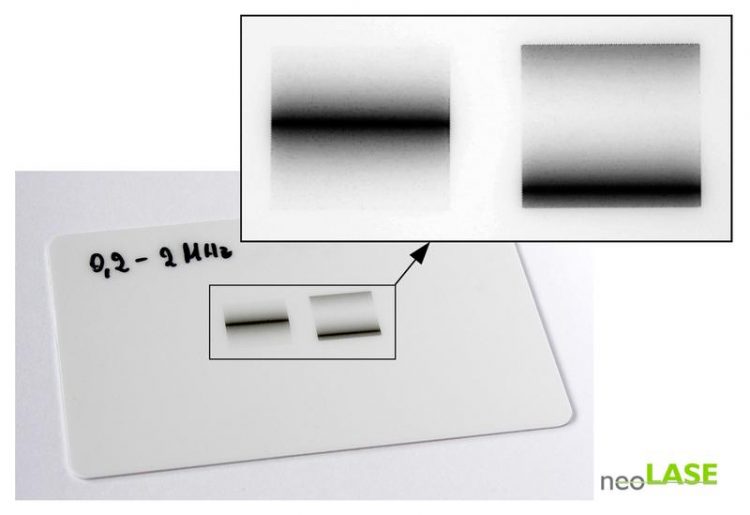FlexPulse: Picosecond pulses with arbitrary pulse sequence and energy

Fig. 1: Gray scale picture produced with constant scan speed
The increasing demands in laser material applications require high flexible and comprehensive laser systems.
For these areas neoLASE developed a new picosecond laser system with a unique flexibility in terms of pulse control.
With the flex pulse technology the lasers repetition rate and the pulse energy can be changed continuously. The system is based on a laser diode emitting 70 ps long laser pulses which can be triggered (PLS) for each pulse individually.
The pulses sequence therefore can be arbitrary and set from single pulses up to 80 MHz repetition rates or can be synchronized with scanners or moving axes.
The use of a frequency sweep for example can produce gray scale pictures without changing the scanners speed (Fig.1). A second control input (PWR) enables free pulse energy control up to 250 µJ which can be correlated to changes in the repetition rate or adapted to different processing steps.
The full flexibility of the system is illustrated in Fig.2 showing that the pulse sequence and energy can be adapted to the application.
This and other new developments will be presented at neoLASE booth on Laser World of Photonics Hall A3 booth 438/2 or visit neoLASE webpage under www.neoLASE.com
Media Contact
All latest news from the category: Machine Engineering
Machine engineering is one of Germany’s key industries. The importance of this segment has led to the creation of new university degree programs in fields such as production and logistics, process engineering, vehicle/automotive engineering, production engineering and aerospace engineering among others.
innovations-report offers informative reports and articles covering technologies such as automation, motion, power train, energy, conveyor, plastics, lightweight construction, logistics/warehousing, measurement systems, machine tools and control engineering.
Newest articles

You are What You Eat—Stanford Study Links Fiber to Anti-Cancer Gene Modulation
The Fiber Gap: A Growing Concern in American Diets Fiber is well known to be an important part of a healthy diet, yet less than 10% of Americans eat the minimum recommended…

Trust Your Gut—RNA-Protein Discovery for Better Immunity
HIRI researchers uncover control mechanisms of polysaccharide utilization in Bacteroides thetaiotaomicron. Researchers at the Helmholtz Institute for RNA-based Infection Research (HIRI) and the Julius-Maximilians-Universität (JMU) in Würzburg have identified a…

ASXL1 Mutation: The Hidden Trigger Behind Blood Cancers and Inflammation
Scientists show how a mutated gene harms red and white blood cells. LA JOLLA, CA—Scientists at La Jolla Institute for Immunology (LJI) have discovered how a mutated gene kicks off…



